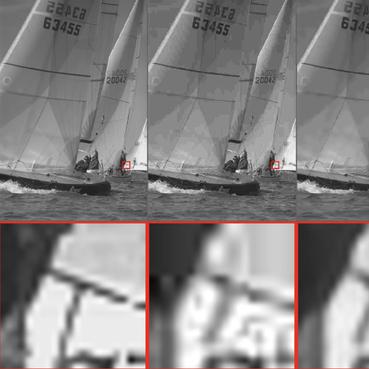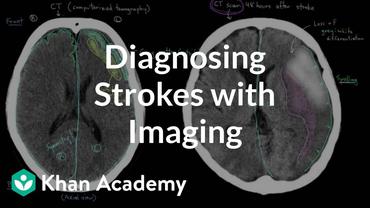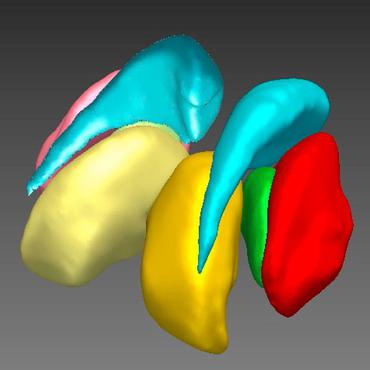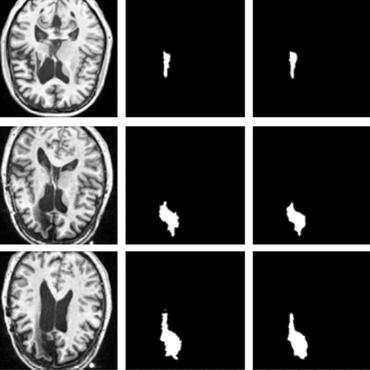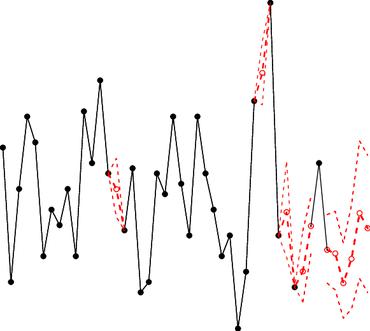Search Results for author: Ho Hin Lee
Found 33 papers, 13 papers with code
BiomedParse: a biomedical foundation model for image parsing of everything everywhere all at once
no code implementations • 21 May 2024 • Theodore Zhao, Yu Gu, Jianwei Yang, Naoto Usuyama, Ho Hin Lee, Tristan Naumann, Jianfeng Gao, Angela Crabtree, Brian Piening, Carlo Bifulco, Mu Wei, Hoifung Poon, Sheng Wang
On object recognition, which aims to identify all objects in a given image along with their semantic types, we showed that BiomedParse can simultaneously segment and label all biomedical objects in an image (all at once).
Foundation Models for Biomedical Image Segmentation: A Survey
no code implementations • 15 Jan 2024 • Ho Hin Lee, Yu Gu, Theodore Zhao, Yanbo Xu, Jianwei Yang, Naoto Usuyama, Cliff Wong, Mu Wei, Bennett A. Landman, Yuankai Huo, Alberto Santamaria-Pang, Hoifung Poon
This transformative technology, originally developed for general-purpose computer vision, has found rapid application in medical image processing.
Nucleus subtype classification using inter-modality learning
no code implementations • 11 Jan 2024 • Lucas W. Remedios, Shunxing Bao, Samuel W. Remedios, Ho Hin Lee, Leon Y. Cai, Thomas Li, Ruining Deng, Can Cui, Jia Li, Qi Liu, Ken S. Lau, Joseph T. Roland, Mary K. Washington, Lori A. Coburn, Keith T. Wilson, Yuankai Huo, Bennett A. Landman
In this paper, we propose to use inter-modality learning to label previously un-labelable cell types on virtual H&E.
Super-Resolution Multi-Contrast Unbiased Eye Atlases With Deep Probabilistic Refinement
no code implementations • 5 Jan 2024 • Ho Hin Lee, Adam M. Saunders, Michael E. Kim, Samuel W. Remedios, Yucheng Tang, Qi Yang, Xin Yu, Shunxing Bao, Chloe Cho, Louise A. Mawn, Tonia S. Rex, Kevin L. Schey, Blake E. Dewey, Jeffrey M. Spraggins, Jerry L. Prince, Yuankai Huo, Bennett A. Landman
These variations limit the feasibility and robustness of generalizing population-wise features of eye organs to an unbiased spatial reference.
3D-MIR: A Benchmark and Empirical Study on 3D Medical Image Retrieval in Radiology
1 code implementation • 23 Nov 2023 • Asma Ben Abacha, Alberto Santamaria-Pang, Ho Hin Lee, Jameson Merkow, Qin Cai, Surya Teja Devarakonda, Abdullah Islam, Julia Gong, Matthew P. Lungren, Thomas Lin, Noel C Codella, Ivan Tarapov
The increasing use of medical imaging in healthcare settings presents a significant challenge due to the increasing workload for radiologists, yet it also offers opportunity for enhancing healthcare outcomes if effectively leveraged.
Predicting Age from White Matter Diffusivity with Residual Learning
no code implementations • 6 Nov 2023 • Chenyu Gao, Michael E. Kim, Ho Hin Lee, Qi Yang, Nazirah Mohd Khairi, Praitayini Kanakaraj, Nancy R. Newlin, Derek B. Archer, Angela L. Jefferson, Warren D. Taylor, Brian D. Boyd, Lori L. Beason-Held, Susan M. Resnick, The BIOCARD Study Team, Yuankai Huo, Katherine D. Van Schaik, Kurt G. Schilling, Daniel Moyer, Ivana Išgum, Bennett A. Landman
We find that the ResNet model captures subtler, non-macrostructural features for brain age prediction.
DeformUX-Net: Exploring a 3D Foundation Backbone for Medical Image Segmentation with Depthwise Deformable Convolution
1 code implementation • 30 Sep 2023 • Ho Hin Lee, Quan Liu, Qi Yang, Xin Yu, Shunxing Bao, Yuankai Huo, Bennett A. Landman
We hypothesize that deformable convolution can be an exploratory alternative to combine all advantages from the previous operators, providing long-range dependency, adaptive spatial aggregation and computational efficiency as a foundation backbone.
Inter-vendor harmonization of Computed Tomography (CT) reconstruction kernels using unpaired image translation
no code implementations • 22 Sep 2023 • Aravind R. Krishnan, Kaiwen Xu, Thomas Li, Chenyu Gao, Lucas W. Remedios, Praitayini Kanakaraj, Ho Hin Lee, Shunxing Bao, Kim L. Sandler, Fabien Maldonado, Ivana Isgum, Bennett A. Landman
In this study, we adopt an unpaired image translation approach to investigate harmonization between and across reconstruction kernels from different manufacturers by constructing a multipath cycle generative adversarial network (GAN).
Deep conditional generative models for longitudinal single-slice abdominal computed tomography harmonization
1 code implementation • 17 Sep 2023 • Xin Yu, Qi Yang, Yucheng Tang, Riqiang Gao, Shunxing Bao, Leon Y. Cai, Ho Hin Lee, Yuankai Huo, Ann Zenobia Moore, Luigi Ferrucci, Bennett A. Landman
We further evaluate our method's capability to harmonize longitudinal positional variation on 1033 subjects from the Baltimore Longitudinal Study of Aging (BLSA) dataset, which contains longitudinal single abdominal slices, and confirmed that our method can harmonize the slice positional variance in terms of visceral fat area.
Enhancing Hierarchical Transformers for Whole Brain Segmentation with Intracranial Measurements Integration
1 code implementation • 8 Sep 2023 • Xin Yu, Yucheng Tang, Qi Yang, Ho Hin Lee, Shunxing Bao, Yuankai Huo, Bennett A. Landman
Subsequently, the model is finetuned with 45 T1w 3D volumes from Open Access Series Imaging Studies (OASIS) where both 133 whole brain classes and TICV/PFV labels are available.
Digital Modeling on Large Kernel Metamaterial Neural Network
no code implementations • 21 Jul 2023 • Quan Liu, Hanyu Zheng, Brandon T. Swartz, Ho Hin Lee, Zuhayr Asad, Ivan Kravchenko, Jason G. Valentine, Yuankai Huo
However, the digital design of the metamaterial neural network (MNN) is fundamentally limited by its physical limitations, such as precision, noise, and bandwidth during fabrication.
Multi-Contrast Computed Tomography Atlas of Healthy Pancreas
no code implementations • 2 Jun 2023 • Yinchi Zhou, Ho Hin Lee, Yucheng Tang, Xin Yu, Qi Yang, Shunxing Bao, Jeffrey M. Spraggins, Yuankai Huo, Bennett A. Landman
Briefly, DEEDs affine and non-rigid registration are performed to transfer patient abdominal volumes to a fixed high-resolution atlas template.
Region-based Contrastive Pretraining for Medical Image Retrieval with Anatomic Query
no code implementations • 9 May 2023 • Ho Hin Lee, Alberto Santamaria-Pang, Jameson Merkow, Ozan Oktay, Fernando Pérez-García, Javier Alvarez-Valle, Ivan Tarapov
We introduce a novel Region-based contrastive pretraining for Medical Image Retrieval (RegionMIR) that demonstrates the feasibility of medical image retrieval with similar anatomical regions.
Longitudinal Multimodal Transformer Integrating Imaging and Latent Clinical Signatures From Routine EHRs for Pulmonary Nodule Classification
1 code implementation • 6 Apr 2023 • Thomas Z. Li, John M. Still, Kaiwen Xu, Ho Hin Lee, Leon Y. Cai, Aravind R. Krishnan, Riqiang Gao, Mirza S. Khan, Sanja Antic, Michael Kammer, Kim L. Sandler, Fabien Maldonado, Bennett A. Landman, Thomas A. Lasko
In this work, we propose a transformer-based multimodal strategy to integrate repeat imaging with longitudinal clinical signatures from routinely collected EHRs for SPN classification.
Scaling Up 3D Kernels with Bayesian Frequency Re-parameterization for Medical Image Segmentation
2 code implementations • 10 Mar 2023 • Ho Hin Lee, Quan Liu, Shunxing Bao, Qi Yang, Xin Yu, Leon Y. Cai, Thomas Li, Yuankai Huo, Xenofon Koutsoukos, Bennett A. Landman
We hypothesize that convolution with LK sizes is limited to maintain an optimal convergence for locality learning.
Single Slice Thigh CT Muscle Group Segmentation with Domain Adaptation and Self-Training
1 code implementation • 30 Nov 2022 • Qi Yang, Xin Yu, Ho Hin Lee, Leon Y. Cai, Kaiwen Xu, Shunxing Bao, Yuankai Huo, Ann Zenobia Moore, Sokratis Makrogiannis, Luigi Ferrucci, Bennett A. Landman
The proposed pipeline is effective and robust in extracting muscle groups on 2D single slice CT thigh images. The container is available for public use at https://github. com/MASILab/DA_CT_muscle_seg
Adaptive Contrastive Learning with Dynamic Correlation for Multi-Phase Organ Segmentation
1 code implementation • 16 Oct 2022 • Ho Hin Lee, Yucheng Tang, Han Liu, Yubo Fan, Leon Y. Cai, Qi Yang, Xin Yu, Shunxing Bao, Yuankai Huo, Bennett A. Landman
We evaluate our proposed approach on multi-organ segmentation with both non-contrast CT (NCCT) datasets and the MICCAI 2015 BTCV Challenge contrast-enhance CT (CECT) datasets.
3D UX-Net: A Large Kernel Volumetric ConvNet Modernizing Hierarchical Transformer for Medical Image Segmentation
2 code implementations • 29 Sep 2022 • Ho Hin Lee, Shunxing Bao, Yuankai Huo, Bennett A. Landman
Hierarchical transformers (e. g., Swin Transformers) reintroduced several ConvNet priors and further enhanced the practical viability of adapting volumetric segmentation in 3D medical datasets.
UNesT: Local Spatial Representation Learning with Hierarchical Transformer for Efficient Medical Segmentation
1 code implementation • 28 Sep 2022 • Xin Yu, Qi Yang, Yinchi Zhou, Leon Y. Cai, Riqiang Gao, Ho Hin Lee, Thomas Li, Shunxing Bao, Zhoubing Xu, Thomas A. Lasko, Richard G. Abramson, Zizhao Zhang, Yuankai Huo, Bennett A. Landman, Yucheng Tang
Transformer-based models, capable of learning better global dependencies, have recently demonstrated exceptional representation learning capabilities in computer vision and medical image analysis.
Reducing Positional Variance in Cross-sectional Abdominal CT Slices with Deep Conditional Generative Models
1 code implementation • 28 Sep 2022 • Xin Yu, Qi Yang, Yucheng Tang, Riqiang Gao, Shunxing Bao, LeonY. Cai, Ho Hin Lee, Yuankai Huo, Ann Zenobia Moore, Luigi Ferrucci, Bennett A. Landman
External experiments on 20 subjects from the Baltimore Longitudinal Study of Aging (BLSA) dataset that contains longitudinal single abdominal slices validate that our method can harmonize the slice positional variance in terms of muscle and visceral fat area.
Longitudinal Variability Analysis on Low-dose Abdominal CT with Deep Learning-based Segmentation
no code implementations • 28 Sep 2022 • Xin Yu, Yucheng Tang, Qi Yang, Ho Hin Lee, Riqiang Gao, Shunxing Bao, Ann Zenobia Moore, Luigi Ferrucci, Bennett A. Landman
Metabolic health is increasingly implicated as a risk factor across conditions from cardiology to neurology, and efficiency assessment of body composition is critical to quantitatively characterizing these relationships.
Pseudo-Label Guided Multi-Contrast Generalization for Non-Contrast Organ-Aware Segmentation
no code implementations • 12 May 2022 • Ho Hin Lee, Yucheng Tang, Riqiang Gao, Qi Yang, Xin Yu, Shunxing Bao, James G. Terry, J. Jeffrey Carr, Yuankai Huo, Bennett A. Landman
In this paper, we propose a novel unsupervised approach that leverages pairwise contrast-enhanced CT (CECT) context to compute non-contrast segmentation without ground-truth label.
ModDrop++: A Dynamic Filter Network with Intra-subject Co-training for Multiple Sclerosis Lesion Segmentation with Missing Modalities
1 code implementation • 7 Mar 2022 • Han Liu, Yubo Fan, Hao Li, Jiacheng Wang, Dewei Hu, Can Cui, Ho Hin Lee, Huahong Zhang, Ipek Oguz
Previously, a training strategy termed Modality Dropout (ModDrop) has been applied to MS lesion segmentation to achieve the state-of-the-art performance with missing modality.
Characterizing Renal Structures with 3D Block Aggregate Transformers
no code implementations • 4 Mar 2022 • Xin Yu, Yucheng Tang, Yinchi Zhou, Riqiang Gao, Qi Yang, Ho Hin Lee, Thomas Li, Shunxing Bao, Yuankai Huo, Zhoubing Xu, Thomas A. Lasko, Richard G. Abramson, Bennett A. Landman
Efficiently quantifying renal structures can provide distinct spatial context and facilitate biomarker discovery for kidney morphology.
Random Multi-Channel Image Synthesis for Multiplexed Immunofluorescence Imaging
no code implementations • MICCAI Workshop COMPAY 2021 • Shunxing Bao, Yucheng Tang, Ho Hin Lee, Riqiang Gao, Sophie Chiron, Ilwoo Lyu, Lori A. Coburn, Keith T. Wilson, Joseph T. Roland, Bennett A. Landman, Yuankai Huo
Our contribution is three-fold: (1) a single deep network framework is proposed to tackle missing stain in MxIF; (2) the proposed 'N-to-N' strategy reduces theoretical four years of computational time to 20 hours when covering all possible missing stains scenarios, with up to five missing stains (e. g., '(N-1)-to-1', '(N-2)-to-2'); and (3) this work is the first comprehensive experimental study of investigating cross-stain synthesis in MxIF.
Lung Cancer Risk Estimation with Incomplete Data: A Joint Missing Imputation Perspective
no code implementations • 25 Jul 2021 • Riqiang Gao, Yucheng Tang, Kaiwen Xu, Ho Hin Lee, Steve Deppen, Kim Sandler, Pierre Massion, Thomas A. Lasko, Yuankai Huo, Bennett A. Landman
To our knowledge, it is the first generative adversarial model that addresses multi-modal missing imputation by modeling the joint distribution of image and non-image data.
Semantic-Aware Contrastive Learning for Multi-object Medical Image Segmentation
no code implementations • 3 Jun 2021 • Ho Hin Lee, Yucheng Tang, Qi Yang, Xin Yu, Shunxing Bao, Leon Y. Cai, Lucas W. Remedios, Bennett A. Landman, Yuankai Huo
Medical image segmentation, or computing voxelwise semantic masks, is a fundamental yet challenging task to compute a voxel-level semantic mask.
Multi-Contrast Computed Tomography Healthy Kidney Atlas
no code implementations • 23 Dec 2020 • Ho Hin Lee, Yucheng Tang, Kaiwen Xu, Shunxing Bao, Agnes B. Fogo, Raymond Harris, Mark P. de Caestecker, Mattias Heinrich, Jeffrey M. Spraggins, Yuankai Huo, Bennett A. Landman
However, there is no abdominal and retroperitoneal organs atlas framework for multi-contrast CT.
RAP-Net: Coarse-to-Fine Multi-Organ Segmentation with Single Random Anatomical Prior
1 code implementation • 23 Dec 2020 • Ho Hin Lee, Yucheng Tang, Shunxing Bao, Richard G. Abramson, Yuankai Huo, Bennett A. Landman
We combine the anatomical prior with corresponding extracted patches to preserve the anatomical locations and boundary information for performing high-resolution segmentation across all organs in a single model.
Outlier Guided Optimization of Abdominal Segmentation
no code implementations • 10 Feb 2020 • Yuchen Xu, Olivia Tang, Yucheng Tang, Ho Hin Lee, Yunqiang Chen, Dashan Gao, Shizhong Han, Riqiang Gao, Michael R. Savona, Richard G. Abramson, Yuankai Huo, Bennett A. Landman
We built on a pre-trained 3D U-Net model for abdominal multi-organ segmentation and augmented the dataset either with outlier data (e. g., exemplars for which the baseline algorithm failed) or inliers (e. g., exemplars for which the baseline algorithm worked).
Validation and Optimization of Multi-Organ Segmentation on Clinical Imaging Archives
no code implementations • 10 Feb 2020 • Yuchen Xu, Olivia Tang, Yucheng Tang, Ho Hin Lee, Yunqiang Chen, Dashan Gao, Shizhong Han, Riqiang Gao, Michael R. Savona, Richard G. Abramson, Yuankai Huo, Bennett A. Landman
A 2015 MICCAI challenge spurred substantial innovation in multi-organ abdominal CT segmentation with both traditional and deep learning methods.
Contrast Phase Classification with a Generative Adversarial Network
no code implementations • 14 Nov 2019 • Yucheng Tang, Ho Hin Lee, Yuchen Xu, Olivia Tang, Yunqiang Chen, Dashan Gao, Shizhong Han, Riqiang Gao, Camilo Bermudez, Michael R. Savona, Richard G. Abramson, Yuankai Huo, Bennett A. Landman
Dynamic contrast enhanced computed tomography (CT) is an imaging technique that provides critical information on the relationship of vascular structure and dynamics in the context of underlying anatomy.
Semi-Supervised Multi-Organ Segmentation through Quality Assurance Supervision
no code implementations • 12 Nov 2019 • Ho Hin Lee, Yucheng Tang, Olivia Tang, Yuchen Xu, Yunqiang Chen, Dashan Gao, Shizhong Han, Riqiang Gao, Michael R. Savona, Richard G. Abramson, Yuankai Huo, Bennett A. Landman
The contributions of the proposed method are threefold: We show that (1) the QA scores can be used as a loss function to perform semi-supervised learning for unlabeled data, (2) the well trained discriminator is learnt by QA score rather than traditional true/false, and (3) the performance of multi-organ segmentation on unlabeled datasets can be fine-tuned with more robust and higher accuracy than the original baseline method.




